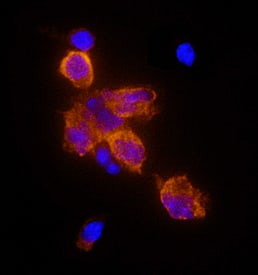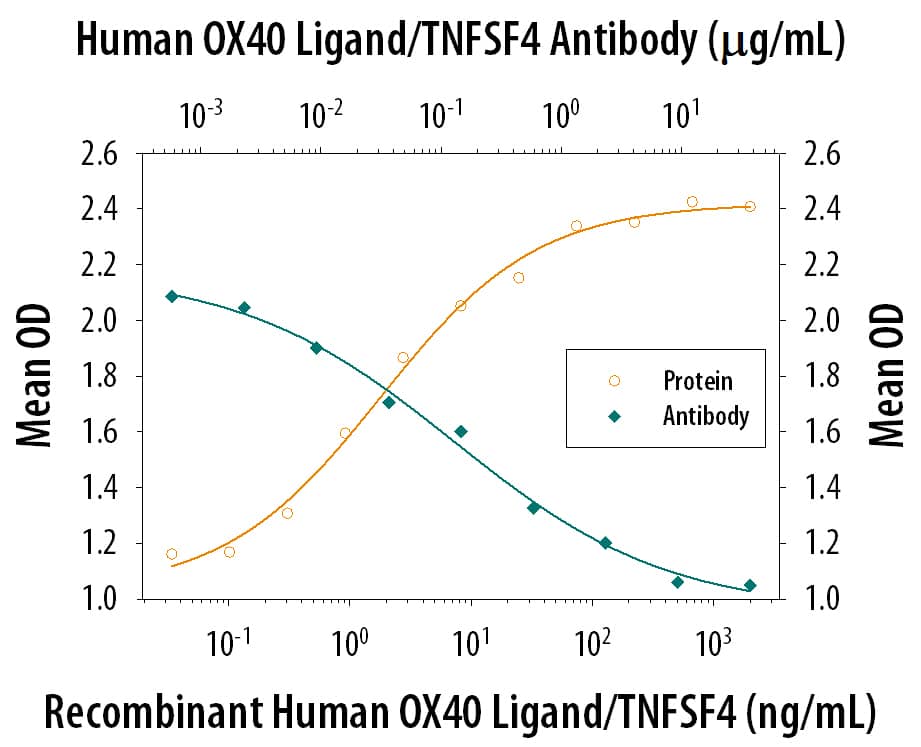Human OX40 Ligand/TNFSF4 Antibody
R&D Systems, part of Bio-Techne | Catalog # MAB10541


Key Product Details
Validated by
Species Reactivity
Validated:
Cited:
Applications
Validated:
Cited:
Label
Antibody Source
Product Specifications
Immunogen
Gln51-Leu183
Accession # P23510
Specificity
Clonality
Host
Isotype
Endotoxin Level
Scientific Data Images for Human OX40 Ligand/TNFSF4 Antibody
Detection of OX40 Ligand/ TNFSF4 in Human Mature Dendritic Cells by Flow Cytometry.
Human mature dentritic cells differentated from human peripheral blood mononuclear cell derived CD14+cells treated with 20 ng/mL Recombinant Human IL-4 (Catalog # 204-IL) and 50 ng/mL Recombinant Human GM-CSF (Catalog # 215-GM) for 7 days and 1 µg/mL LPS, 20 ng/mL Recombinant Human TNF-a (Catalog # 210-TA), and 20 ng/mL Recombinant Human IL-1 beta/IL-1F2 (Catalog # 201-LB) for last 24 hours were stained with Mouse Anti-Human OX40 Ligand/TNFSF4 Monoclonal Antibody(Catalog # MAB10541, filled histogram) or isotype control (Catalog # MAB002, open histogram), followed by Goat F(ab)2 Anti-Mouse IgG (H+L) Allophycocyanin (Catalog # F0101B).OX40 Ligand/TNFSF4 in Human PBMCs.
OX40 Ligand/TNFSF4 was detected in immersion fixed human peripheral blood mononuclear cells (PBMCs) stimulated with LPS using Mouse Anti-Human OX40 Ligand/ TNFSF4 Monoclonal Antibody (Catalog # MAB10541) at 25 µg/mL for 3 hours at room temperature. Cells were stained using the NorthernLights™ 557-conjugated Anti-Mouse IgG Secondary Antibody (orange; Catalog # NL007) and counterstained with DAPI (blue). View our protocol for Fluorescent ICC Staining of Non-adherent Cells.IL‑8 Secretion Induced by OX40 Ligand/TNFSF4 and Neutralization by Human OX40 Ligand/TNFSF4 Antibody.
Recombinant Human OX40 Ligand/TNFSF4 (Catalog # 1054-OX) induces IL-8 secretion in the HT1080 human fibrosarcoma cell line transfected with human OX40 in a dose-dependent manner (orange line) as measured by Human IL-8 Duoset (Catalog # DY208). IL-8 Secretion elicited by Recombinant Human OX40 Ligand/TNFSF4 (10 ng/mL) is neutralized (green line) by increasing concentrations of Mouse Anti-Human OX40 Ligand/TNFSF4 Monoclonal Antibody (Catalog # MAB10541). The ND50 is typically 0.1-0.6 µg/mL.Applications for Human OX40 Ligand/TNFSF4 Antibody
CyTOF-ready
Flow Cytometry
Sample: Human mature dentritic cells differentated from human peripheral blood mononuclear cell derived CD14+ cells treated with Recombinant Human IL‑4 (Catalog # 204-IL), Recombinant Human GM‑CSF (Catalog # 215-GM), LPS, Recombinant Human TNF‑ alpha (Catalog # 210-TA), and Recombinant Human IL‑1 beta/IL‑1F2 (Catalog # 201-LB)
Immunocytochemistry
Sample: Immersion fixed human peripheral blood mononuclear cells stimulated with LPS
Neutralization
Formulation, Preparation, and Storage
Purification
Reconstitution
Formulation
Shipping
Stability & Storage
- 12 months from date of receipt, -20 to -70 °C as supplied.
- 1 month, 2 to 8 °C under sterile conditions after reconstitution.
- 6 months, -20 to -70 °C under sterile conditions after reconstitution.
Background: OX40 Ligand/TNFSF4
OX40 Ligand (OX40L), also known as gp34, is a type II transmembrane glycoprotein designated TNFSF4 within the TNF superfamily. Human OX40L cDNA encodes a 183 amino acids (aa) polypeptide with an amino-terminal cytoplasmic domain (aa 1-23) and a carboxy-terminal extracellular domain (aa 51-183). It shares 46% aa sequence identity with the mouse counterpart. OX40L is expressed on the surface of activated B cells, T cells, dendritic cells and endothelial cells. Like other TNF superfamily members, membrane-bound OX40 Ligand exists as a homotrimer. OX40L binds to OX40 (CD134), a member of the TNF receptor superfamily that is expressed predominantly on activated CD4+ T cells. OX40 Ligand is one of the group of co-stimulatory molecules in the immune system that includes B7, CD40 Ligand, CD30 Ligand, CD27 Ligand and 4-1BB Ligand. OX40 appears as a late activation-induced T cell surface antigen, and its major function of OX40-OX40L interaction may be to transmit a late co-stimulatory signal to promote the survival and proliferation of activated CD4+ T cells and prolong the immune response. Engagement of OX40 on activated T cells in situ in tumors has been shown to augment immune responses and subsequent tumor regression.
References
- Godfrey, W.R. et al. (1994) J. Exp. Med. 180:757.
- Baum, P.R. et al. (1994) EMBO J. 13:3992.
- Al-Shamkhani, A. et al. (1997) J. Biol. Chem. 272:5275.
- Kjaergaard, J. et al. (2000) Cancer Res. 60:5514.
Alternate Names
Gene Symbol
UniProt
Additional OX40 Ligand/TNFSF4 Products
Product Documents for Human OX40 Ligand/TNFSF4 Antibody
Product Specific Notices for Human OX40 Ligand/TNFSF4 Antibody
For research use only


